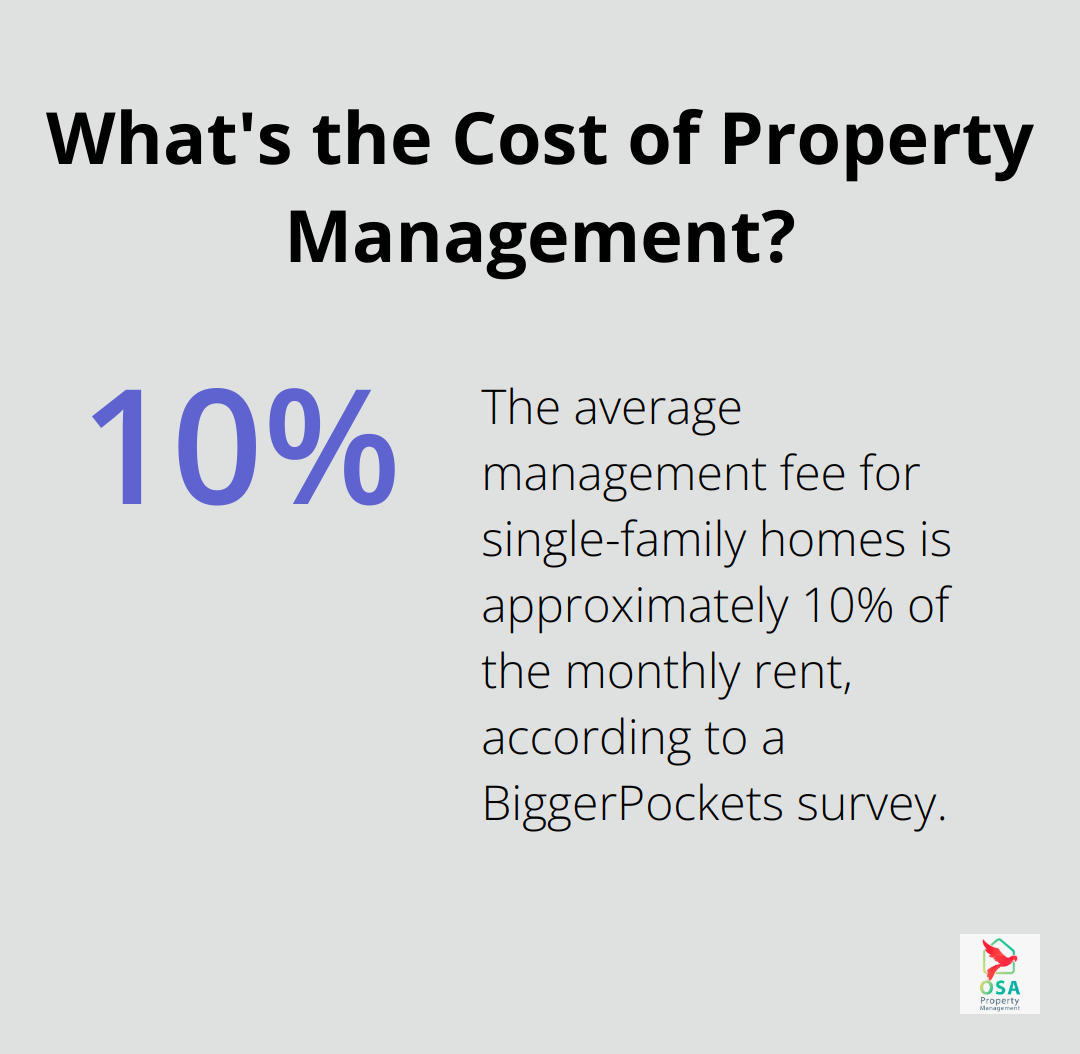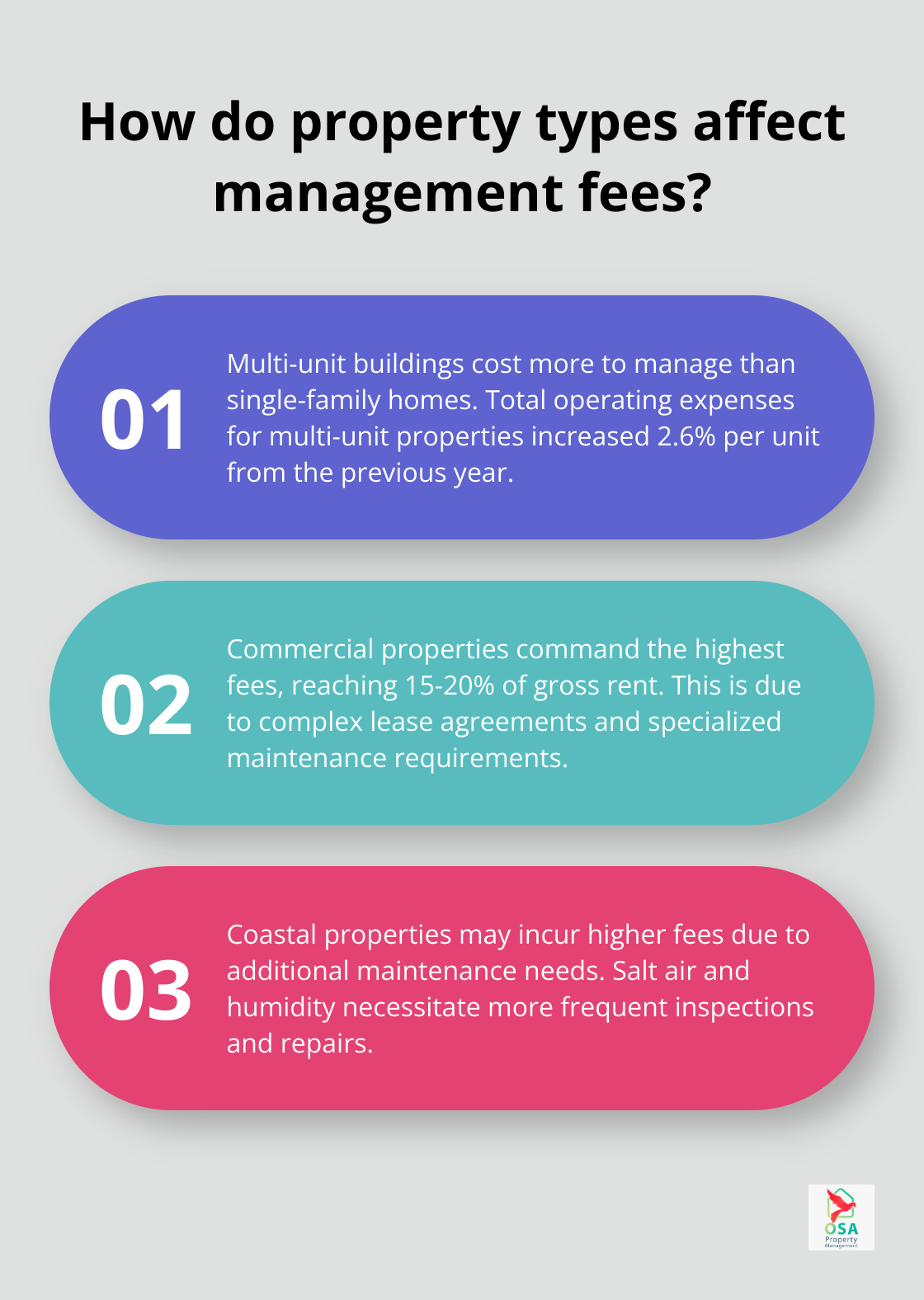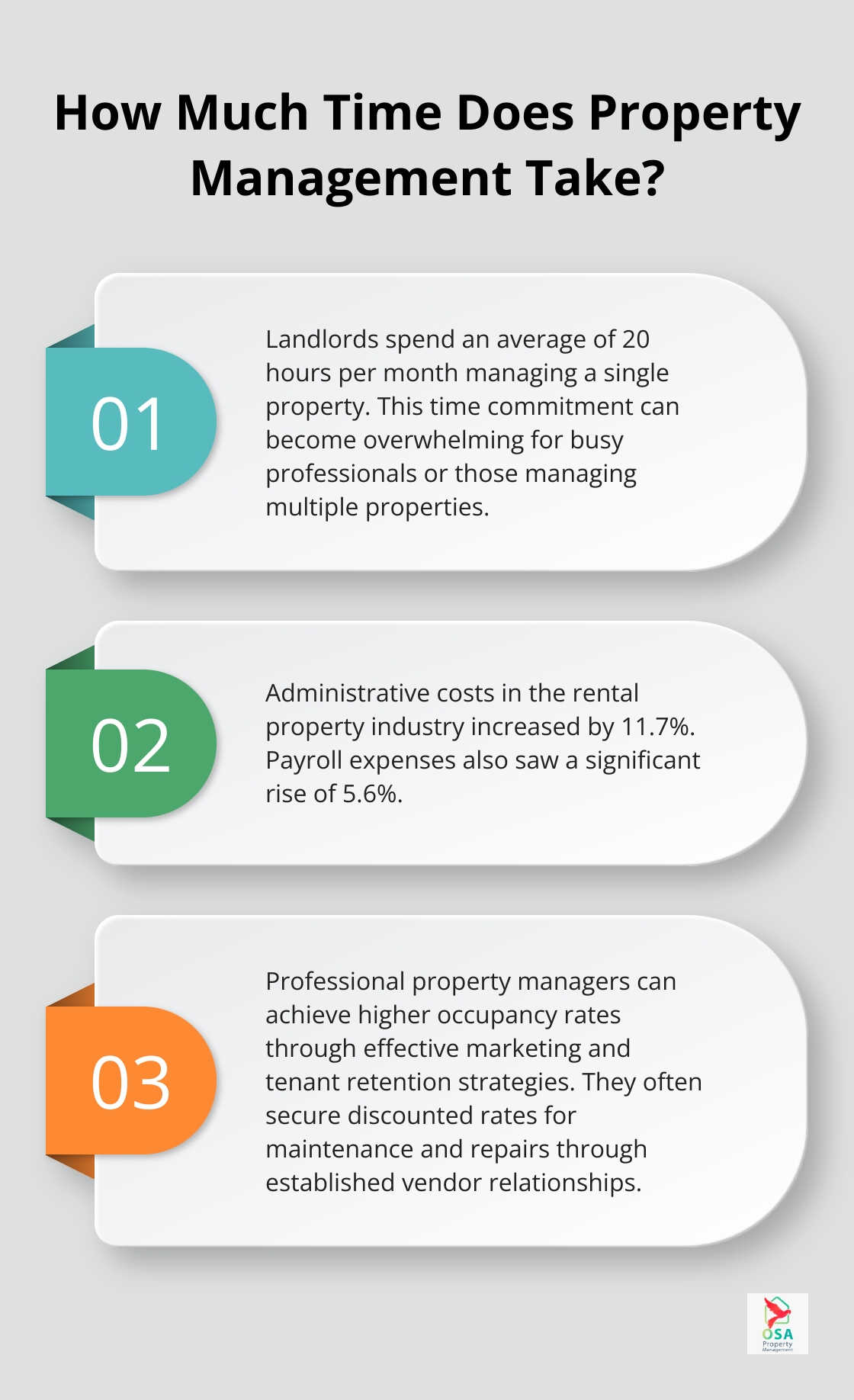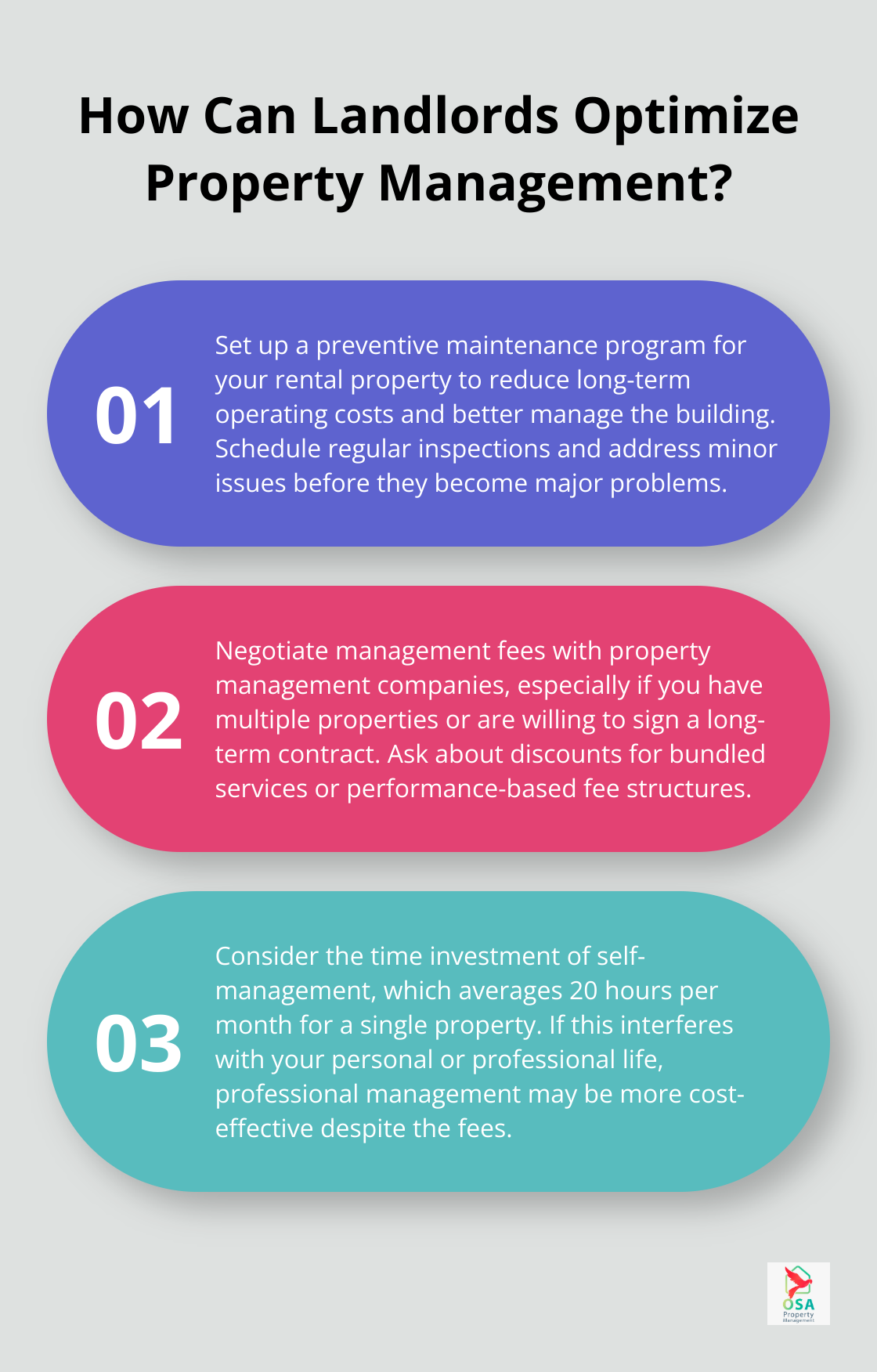At Osa Property Management, we often field questions about rental management costs. Understanding how much rental management companies charge is crucial for property owners considering professional assistance.
This comprehensive guide breaks down fee structures, explores factors influencing costs, and compares DIY management to professional services.
We’ll provide you with the insights needed to make an informed decision about your rental property management strategy.
What Do Rental Management Companies Charge?
Fee Structures: Flat Rate vs. Percentage-Based
Rental management companies typically use two main fee structures: flat rate and percentage-based. Flat rate fees range from $100 to $200 per property monthly. Owners of high-value properties often prefer this structure as the fee remains constant regardless of rental income.
Percentage-based fees are more common, ranging from 8% to 12% of the monthly rent collected. This structure motivates management companies to maximize rental income.
Average Fee Ranges for Different Property Types
Single-family homes usually incur lower management fees compared to multi-unit or commercial properties. A BiggerPockets survey indicates the average management fee for single-family homes is approximately 10% of the monthly rent.

Multi-unit residential properties’ fees range from 4% to 12%, depending on unit numbers and service levels. Commercial properties command higher fees (15% to 20% of gross rent) due to their management complexity.
Additional Services and Extra Charges
Basic management fees cover most day-to-day operations, but specific services often incur additional charges:
- Tenant Placement Fees: Range from 50% to 100% of the first month’s rent, covering marketing, screening, and lease preparation.
- Maintenance and Repairs: Extra charges apply, especially for after-hours emergencies. Some companies add a 10% to 20% markup on contractor invoices.
- Lease Renewal Fees: Cost between $200 and $500, covering administrative work for extending a tenant’s lease.
Hidden Costs to Consider
When evaluating rental management companies, property owners should be aware of potential hidden costs:
- Vacancy Fees: Some companies charge a fee (often a percentage of potential rent) during periods when the property is unoccupied.
- Administrative Fees: These may include charges for financial reporting, property inspections, or handling legal issues.
- Early Termination Fees: If you decide to end the management contract early, you might face substantial penalties (up to several months’ worth of management fees).
Negotiating Management Fees
Property owners can often negotiate better rates, especially when managing multiple properties or signing long-term contracts. Some companies offer discounts for bundled services or performance-based fee structures.
The key to understanding rental management costs lies in thorough research and open communication with potential management companies. As we move forward, we’ll explore the factors that influence these management fees and how they can vary based on your specific property and needs.
What Drives Rental Management Fees?
Location Impact
Property location plays a significant role in determining management fees. Urban areas with high demand and complex regulations often require higher fees. For example, managing a property in San José, Costa Rica, typically costs more than in rural areas due to increased competition and operational complexities.

Coastal properties (such as those in Manuel Antonio or Jaco) may incur higher fees due to additional maintenance needs caused by salt air and humidity. These environmental factors necessitate more frequent inspections and repairs, which increase management costs.
Property Complexity
The size and type of your rental property directly affect management fees. Multi-unit buildings generally cost more to manage than single-family homes due to the increased number of tenants and potential issues. Total operating expenses for multi-unit properties increased 2.6% from the prior year on a per unit basis, with insurance costs per unit increasing even before the pandemic.
Commercial properties often command the highest fees, sometimes reaching 15-20% of gross rent, due to their complex lease agreements and specialized maintenance requirements.
Service Level Requirements
The scope of services you require from a management company significantly impacts fees. Basic packages typically cover rent collection and maintenance coordination. However, additional services like frequent property inspections, detailed financial reporting, or aggressive marketing campaigns will increase costs.
Some owners of luxury vacation rentals in areas like Dominical or Uvita opt for premium management packages that include concierge services for guests. While this drives up costs, it can potentially increase rental income.
Maintenance and Property Condition
The condition of your property and its maintenance needs play a crucial role in determining management fees. Older properties or those in need of frequent repairs often incur higher fees due to the increased time and resources required for upkeep.
Preventive maintenance programs, while initially more expensive, can lead to long-term cost savings. The International Facility Management Association (IFMA) suggests that proactive maintenance can result in better management of buildings and reduction of operating costs.
Market Trends and Competition
The local real estate market and competition among property management companies can influence fees. In highly competitive markets, companies may offer lower fees or additional services to attract clients. Conversely, in areas with limited options, fees may be higher due to reduced competition.
Understanding these factors allows property owners to better anticipate and budget for management expenses. The next section will explore how these costs compare to self-management and the potential benefits of professional property management services.
DIY vs Professional Management Costs
The Hidden Expenses of Self-Management
Self-management of a rental property involves more than rent collection. Property owners must handle marketing, tenant screening, maintenance, and legal compliance. These tasks can become expensive if not managed properly.

Inadequate tenant screening can lead to problematic renters, resulting in property damage or unpaid rent. Administrative costs were up 11.7%, while payroll expense increases also remained elevated at 5.6% in the rental property industry.
Time Investment Considerations
Self-management requires a significant time commitment. From responding to maintenance requests at odd hours to handling tenant disputes, these responsibilities can interfere with personal and professional life.
A survey by Buildium found that landlords spend an average of 20 hours per month managing a single property. For busy professionals or those managing multiple properties, this time commitment can become overwhelming and potentially impact their primary source of income.
Financial Advantages of Professional Management
While professional management incurs a fee, it often leads to financial benefits that can outweigh the costs. Property management companies have the expertise and resources to maximize rental income and minimize expenses.
Professional managers typically achieve higher occupancy rates through effective marketing and tenant retention strategies. They also have established relationships with vendors, often securing discounted rates for maintenance and repairs.
Some investors find the expertise and time savings of professional management worth the cost, while others prefer the control of self-management.
Legal Compliance and Risk Mitigation
Professional managers stay updated on local regulations, helping property owners avoid costly legal issues. In Costa Rica, where property laws can be complex, this expertise is particularly valuable.
Companies like Osa Property Management offer comprehensive services that include tax compliance and accounting, further reducing the risk of legal complications for property owners.
Making the Right Choice
The decision between DIY and professional management depends on individual circumstances, including time availability, expertise, and financial goals. For many property owners, especially those with multiple properties or those located in Costa Rica’s competitive rental markets (like Manuel Antonio or Jaco), professional management often proves to be the more cost-effective and stress-free option.
Final Thoughts
Rental management companies typically charge between 8% to 12% of monthly rent collected, with flat-rate options ranging from $100 to $200 per property. These fees cover essential services, but additional charges may apply for tenant placement, maintenance, and lease renewals. When evaluating how much rental management companies cost, property owners must weigh these expenses against the potential benefits of professional management.

Professional management can lead to higher occupancy rates, better tenant quality, and reduced legal risks. The time saved on day-to-day operations and emergency responses proves invaluable for many property owners. Expert managers often secure better rates for maintenance and repairs through established vendor relationships.
For property owners in Costa Rica, Osa Property Management offers comprehensive services tailored to the unique needs of the local market. With extensive experience in areas like Tarcoles, Jaco, Dominical, Manuel Antonio, Ojochal, and Uvita, they provide expert management, from marketing and tenant relations to accounting and tax compliance. Their customized service packages ensure cost-effective solutions and peace of mind for homeowners.

